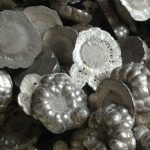Notice: Undefined index: sith_hide_share in /www/sites/alloy.wiki/index/wp-content/themes/likegoogle/single.php on line 32
Deprecated: get_settings is deprecated since version 2.1.0! Use get_option() instead. in /www/sites/alloy.wiki/index/wp-includes/functions.php on line 4862
Titanium alloy is mainly used to make aircraft engine compressor parts, followed by structural parts for rockets, missiles and high-speed aircraft. In the mid-1960s, titanium and its alloys have been used in general industry to make electrodes in the electrolysis industry, condensers in power stations, heaters for petroleum refining and desalination, and environmental pollution control devices. Titanium and its alloys have become a corrosion-resistant structural material. It is also used to produce hydrogen storage materials and shape memory alloys.

Three steps of titanium and titanium alloy polishing technology:
1. Smooth it, use 320grit sandpaper to cool it in water, and grind it for 2~3 minutes to remove the damage layer caused by cutting and make the surface of the sample flat. Use 320grit SiC sandpaper, water cooling, rotation speed 240 RPM, rotation in the same direction*, pressure: 27N (6lbs)/each sample, until the sample is flat.
Note: The removal of the cutting damage layer is the basic task of polishing. If the removal is not clean, the direct result is that the observed phenomenon may be an illusion.
2. For rough polishing, apply 9μm metaDI diamond polishing paste on the perforated TEXMET polishing cloth in advance, use distilled water as the cooling lubricant, and polish for 10-15 minutes. Rough polishing process: 9μm metaDI diamond polishing liquid + metaDI polishing lubricant, using ULTRA-PAD polishing surface, rotating speed 120 RPM, reverse rotation**, pressure: 27N (6lbs)/each sample, time 10min.
3. For final polishing, use MICROCLOTH or MASTERTEX polishing cloth, add MASTERMET silica suspension polishing liquid, and polish for 10-15 minutes. Final polishing process: On the MICROCLOTH polishing surface, use MASTERMET silica polishing liquid, rotating speed 120 RPM, reverse rotation, pressure: 27N (6lbs)/each sample, time 10min.
Note: During the polishing process, the sample needs to be rotated regularly. Most metal alloys have hard phases. If the direction is not rotated, the polished sample will have a black "long tail" on the hard phase, which will affect the quality of the metallography. The key to the "long tail" problem is the direction of turning the sample. It can be rotated 90 degrees or 180 degrees each time.
Guest contributors are welcome at the Alloy Wiki.It is a weekly wiki and guide on alloy information and processing technology, while also about the vast array of opportunities that are present in manufacturing. Our team of writers consists of a Machining Material Supplier / Machinist / Tool and Die Maker, a Biomedical Engineer / Product Development Engineer, a Job Development Coordinator / Adjunct Professor, and a President and CEO of a manufacturing facility.
Link to this article:Three steps of titanium and titanium alloy polishing technology
Reprint Statement: If there are no special instructions, all articles on this site are original. Please indicate the source for reprinting:Alloy Wiki,thanks!^^


